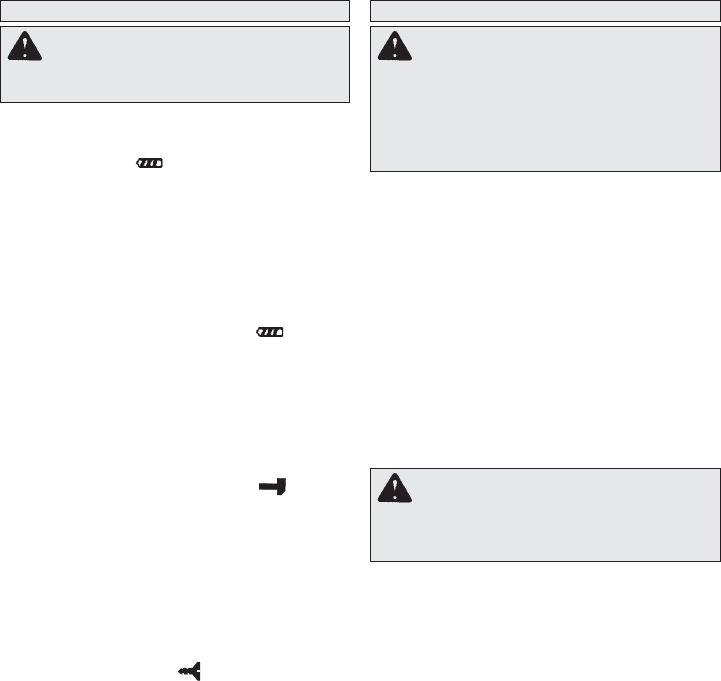
MAINTENANCE
WARNING 7RUHGXFHWKHULVNRISHU-
VRQDOLQMXU\DQGGDPDJHQHYHULPPHUVH\RXU
WRROEDWWHU\SDFNRUFKDUJHULQOLTXLGRUDOORZ
DOLTXLGWRÀRZLQVLGHWKHP
WARNING 7RUHGXFHWKHULVNRILQMXU\
DOZD\VXQSOXJWKHFKDUJHUDQGUHPRYHWKH
EDWWHU\SDFNIURPWKHFKDUJHURUWRROEHIRUH
SHUIRUPLQJDQ\PDLQWHQDQFH1HYHUGLVDV-
VHPEOHWKHWRROEDWWHU\SDFNRUFKDUJHU
&RQWDFWDMILWAUKEEVHUYLFHIDFLOLW\IRU
$//UHSDLUV
0DLQWDLQLQJ7RRO
Keep your tool, battery pack and charger in good
repair by adopting a regular maintenance program.
After six months to one year, depending on use,
return the tool, battery pack and charger to a
MILWAUKEE service facility for:
Lubrication
Mechanical inspection and cleaning (gears,
spindles, bearings, housing, etc.)
Electrical inspection (battery pack, charger,
motor)
Testing to assure proper mechanical and
electrical operation
If the tool does not start or operate at full power
with a fully charged battery pack, clean the contacts
on the battery pack. If the tool still does not work
properly, return the tool, charger and battery pack,
to a MILWAUKEE service facility for repairs.
&OHDQLQJ
Clean dust and debris from charger and tool
vents. Keep tool handles clean, dry and free of oil
or grease. Use only mild soap and a damp cloth
to clean the tool, battery pack and charger since
certain cleaning agents and solvents are harmful to
plastics and other insulated parts. Some of these
include turpentine, lacquer thinner, paint
thinner, chlorinated cleaning solvents, ammonia
and household detergents containing ammonia.
Never use flammable or combustible solvents
around tools.
5HSDLUV
For repairs, return the tool, battery pack and char-
APPLICATIONS
WARNING 7RUHGXFHWKHULVNRIHOHF-
WULFVKRFNFKHFNZRUNDUHDIRUKLGGHQSLSHV
DQGZLUHVEHIRUHGULOOLQJRUGULYLQJVFUHZV
'ULOOLQJLQ:RRG&RPSRVLWLRQ0DWHULDOVDQG
3ODVWLF
When drilling in wood, composition materials and
plastic, select the
drill-only operating mode.
Start the drill slowly, gradually increasing speed as
you drill. When drilling into wood, use wood augers
or twist drill bits. Always use sharp bits. When using
twist drill bits, pull the bit out of the hole frequently
to clear chips from the bit Àutes. To reduce the
chance of splintering, back work with a piece of
scrap wood. Select low speeds for plastics with a
low melting point.
'ULOOLQJLQ0HWDO
When drilling in metal, select the
drill-only
operating mode. Use high speed steel twist drills
or hole saws. Use a center punch to start the hole.
Lubricate drill bits with cutting oil when drilling in
iron or steel. Use a coolant when drilling in nonfer-
rous metals such as copper, brass or aluminum.
Back the material to prevent binding and distortion
on breakthrough.
'ULOOLQJLQ0DVRQU\
When drilling in masonry, select the
hammer
drill operating mode. Use high speed carbide-tipped
bits. Drilling soft masonry materials such as cinder
block requires little pressure. Hard materials like
concrete require more pressure. A smooth, even
Àow of dust indicates the proper drilling rate. Do not
let the bit spin in the hole without cutting. Do not
use water to settle dust or to cool bit. Both actions
will damage the carbide.
'ULYLQJ6FUHZVDQG1XW5XQQLQJ
Drill a pilot hole when driving screws into thick or
hard materials. Select the
driving screws mode.
Set the torque selector collar to the proper position
and set the speed to low. Use the proper style and
size screwdriver bit for the type of screw you are
using. With the screwdriver bit in the screw, place
the tip of the screw on the workpiece and apply ¿rm
pressure before pulling the trigger. Screws can be
removed by reversing the motor.
2YHUORDGLQJ
Continuous overloading may cause permanent
damage to tool or battery pack.
petrol,
ger to the nearest service center, please visit
www.milwaukeetools.com.au /
www.milwaukeetools.co.nz or contact our
customer service centre (Australia Toll Free
Telephone Number 1300 361 505) (New Zealand
Toll Free Telephone Number 0800 279 624).














